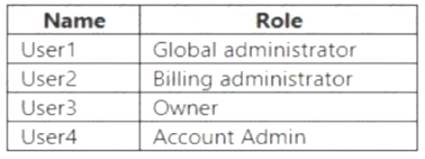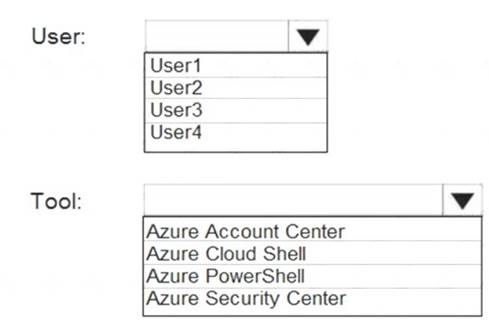- (Exam Topic 4)
HOTSPOT
Your company has an Azure subscription named Subscription1 that contains the users shown in the following table.
The company is sold to a new owner.
The company needs to transfer ownership of Subscription1.
Which user can transfer the ownership and which tool should the user use? To answer, select the appropriate options in the answer area.
NOTE: Each correct selection is worth one point.
Solution:
Box 1; User2
Billing Administrator
Select Transfer billing ownership for the subscription that you want to transfer.
Enter the email address of a user who's a billing administrator of the account that will be the new owner for the subscription.
Box 2: Azure Account Center Azure Account Center can be used. Reference:
https://docs.microsoft.com/en-us/azure/billing/billing-subscription-transfer#transfer-billing-ownership-of-an-azu
Does this meet the goal?
Correct Answer:
A
- (Exam Topic 4)
From Azure Security Center, you enable Azure Container Registry vulnerability scanning of the images in Registry1.
You perform the following actions: Push a Windows image named Image1 to Registry1.
Push a Windows image named Image1 to Registry1.  Push a Linux image named Image2 to Registry1.
Push a Linux image named Image2 to Registry1. Push a Windows image named Image3 to Registry1.
Push a Windows image named Image3 to Registry1. Modify Image1 and push the new image as Image4 to Registry1.
Modify Image1 and push the new image as Image4 to Registry1.  Modify Image2 and push the new image as Image5 to Registry1.
Modify Image2 and push the new image as Image5 to Registry1.
Which two images will be scanned for vulnerabilities? Each correct answer presents a complete solution. NOTE: Each correct selection is worth one point.
Correct Answer:
BC
- (Exam Topic 4)
You have an Azure subscription linked to an Azure Active Directory Premium Plan 1 tenant. You plan to implement Azure Active Directory (Azure AD) Identity Protection.
You need to ensure that you can configure a user risk policy and a sign-in risk policy. What should you do first?
Correct Answer:
A
Reference:
https://docs.microsoft.com/en-us/azure/active-directory/authentication/tutorial-risk-based-sspr-mfa
- (Exam Topic 4)
Note: This question is part of a series of questions that present the same scenario. Each question in the series contains a unique solution that might meet the stated goals. Some question sets might have more than one correct solution, while others might not have a correct solution.
After you answer a question in this section, you will NOT be able to return to it. As a result, these questions will not appear in the review screen.
You have a hybrid configuration of Azure Active Directory (Azure AD).
You have an Azure HDInsight cluster on a virtual network.
You plan to allow users to authenticate to the cluster by using their on-premises Active Directory credentials. You need to configure the environment to support the planned authentication.
Solution: You deploy Azure Active Directory Domain Services (Azure AD DS) to the Azure subscription. Does this meet the goal?
Correct Answer:
A
References:
https://docs.microsoft.com/en-us/azure/hdinsight/domain-joined/apache-domain-joined-configure-using-azure-a
- (Exam Topic 4)
Note: The question is included in a number of questions that depicts the identical set-up. However, every question has a distinctive result. Establish if the solution satisfies the requirements.
Your company has an Active Directory forest with a single domain, named weylandindustries.com. They also have an Azure Active Directory (Azure AD) tenant with the same name.
You have been tasked with integrating Active Directory and the Azure AD tenant. You intend to deploy Azure AD Connect.
Your strategy for the integration must make sure that password policies and user logon limitations affect user accounts that are synced to the Azure AD tenant, and that the amount of necessary servers are reduced.
Solution: You recommend the use of federation with Active Directory Federation Services (AD FS). Does the solution meet the goal?
Correct Answer:
B
A federated authentication system relies on an external trusted system to authenticate users. Some companies want to reuse their existing federated system investment with their Azure AD hybrid identity solution. The maintenance and management of the federated system falls outside the control of Azure AD. It's up to the organization by using the federated system to make sure it's deployed securely and can handle the authentication load.
Reference:
https://docs.microsoft.com/en-us/azure/active-directory/hybrid/how-to-connect-pta

